Feldspars (silicates): Orthoclase
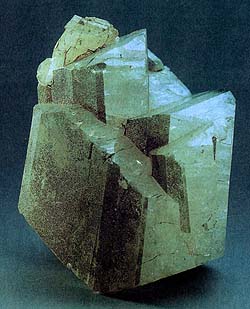 Diagnostic Card.
Diagnostic Card.
On the picture. If the opal stone is whitish complex reflexes deceptively diverse modulations, this kind of jewelry orthoclase - moonstone (adularia).
K Al Si 3 O 8
Crystal system monoclinic
Hardness 6
Specific gravity 2.53-2.63
Cleavage is perfect
fracture conchoidal
Colour colorless, differently colored
Color white powder
Shine from glass to pearl

Lime-sodium feldspar (plagioclase). Crystallizes mostly in the form of crystals is short-rarely - elongated, which may reach gigantic proportions. The crystals are almost always twinned. The mineral is also found in a large dense mass. Fragile and having a conchoidal fracture, orthoclase solid, but fairly easy. It can be both transparent and colorless, sometimes translucent and opaque, colored in white, light gray, pink, yellow color. Shine from glass to pearl, mineral sometimes think of porcelain. he was always in a white powder. Orthoclase has two cleavage planes that intersect at right angles; from this comes its name (orthoclase in Greek means a straight fracture).
Chemical composition. potassium oxide (K2O), 16.9% alumina (Al2O3) 18,4%, silicon dioxide (SiO2) 64,7%, often a few percent of sodium oxide (Na2O); if the number exceeds the number of Na K, a mineral called sodium hydroxide orthoclase or anorthoclase.
Form crystals. Prismatic, columnar, tabular, frequent doubles accretion on the side face of M - the so-called Carlsbad twins. The crystal structure. Silicate with an infinite three-dimensional skeleton (Si, Al) O4. Class symmetry. Prismatic - 2 / m. Cleavage. Very good on the basis (P) (001), at a distinct end faces (M) (010) and prism (T) (110). Aggregates. Dense, granular, shpatopodobnye.
Diagnostic features.
The flame of the candle melts with difficulty. Acids can not be, except for fluoride, which it breaks down completely. Light pink, reddish (flesh color), reddish-white, brown, yellow, white, gray, colorless.
Origin.
Abundant mineral; it is considered the most commonly occurring among the silicates. He is a member of a large number of igneous and metamorphic; moreover, it occurs in the veins of ore in the form of grains in many sedimentary rocks.
Place of Birth.
Beautiful crystals of orthoclase light gray or pinkish coloration observed in geodes Italian granites in San Piero in Campo on Elba Island, as well as in Baveno and Montorfano of Lake Major. Other beautiful crystals are in crystalline schists in the Ziller Valley and Valle Vice in Trentino.
Application.
Orthoclase widely used in the porcelain industry: in mixture with kaolin and quartz, and it gives a fusible plastic mass. High-quality crystals - transparent, with light sparkles, are used in jewelry. As jewels are rarely transparent orthoclase champagne color. It is found in Madagascar and Upper Burma. It can be confused with many transparent yellow stones.
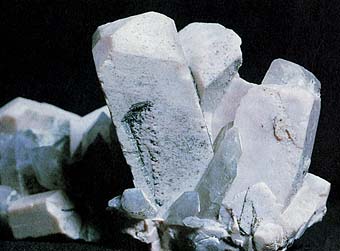
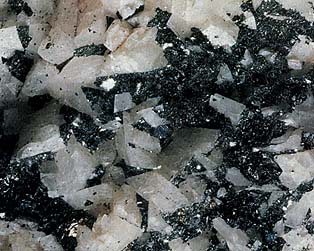
On the picture. Twinned orthoclase. White adularia with scaly black hematite (Rio Marina, Elba Island).
Varieties.
In Monte Adula in Switzerland are great crystals of adularia, transparent variety of orthoclase. If it gleams with opalescent silver-white color, it is called moonstone. White adularia - valensianit - in the form of beautiful crystals produced at the mine Silver City (Idaho).
The name "moonstone" is given for glowing blue iridescence (irisation), the cause of which is tonkoplastinchatoe structure of the mineral. Sometimes it is the effect of "cat's eye". It is very sensitive to shock and compression. The most famous mine is in Sri Lanka, the other - in Australia, Burma, Brazil, India, Madagascar, Tanzania and the United States. GRINDER cabochon. Moonstone can be confused with chalcedony or synthetic spinel. There are also imitations of glass. "Moon" tint may also have albite, oligoclase, microcline.
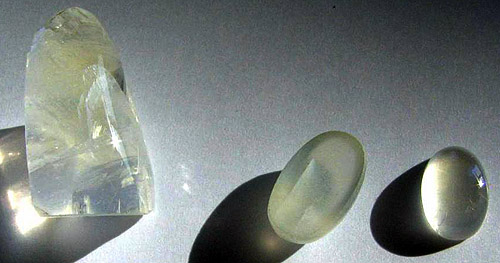
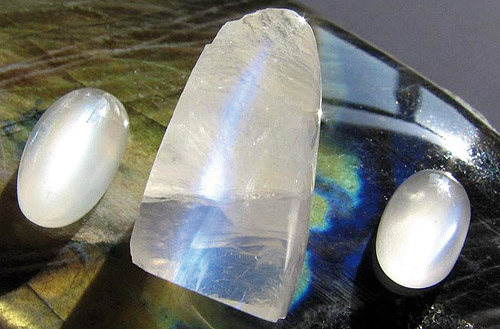
Oligoclase (cabochons in Labrador). Tanzania. Photo: © AA Evseev.
From the family of feldspars - has irrizatsiey (Moonstone)
Anorthoclase - feldspar, which is a solid solution of orthoclase in the album. It is so named because it has no cleavage at a right angle. Distributed in the form of a plate, or mass of the granular structure, painted in grayish-white, light green or light yellow color. Distributed in Pantelleria Island (Italy), on Mount Kilimanjaro in East Africa, Franklin (New Jersey) and many other places.
- Gatchell - "New Almadén snag" - arsenide and antimony sulfide (modern sulphosalts)
- Antimony - toxic metal (semi-metal) are widely used in industry, medicine and engineering
- Zirconium - a rare and non- metal and dangerous jewel in the oxide and salts
- Gold - yellow dangerous and toxic metal -date and accurate digital cable technology
- Sulphur - a golden-yellow toxic substance and a sign of volcanic activity
- Cadmium - a toxic uncirculated unknown wide range of people silvery metal
- Lead - a poisonous gray simulator silver metal and toxic metal snag
- Arsenic - poison classic medieval and modern poisoners and medicine in medicine
Toxic and hazardous radioactive rocks and minerals
** - Poisonous stones and minerals (obligatory check in chemical laboratory + clear indication of toxicity)
** - Radioactive rocks and minerals (obligatory check on a regular dosimeter + ban on the open sale of radioactivity in the event of more than 24 mR / hour + additional measures to protect the population)
Catalog minerals and gems in groups of the world
** - Poisonous stones and minerals
** - Radioactive rocks and minerals


Comments
Commenting, keep in mind that the content and the tone of your messages can hurt the feelings of real people, show respect and tolerance to his interlocutors, even if you do not share their opinion, your behavior in terms of freedom of speech and anonymity offered by the Internet, is changing not only virtual, but real world. All comments are hidden from the index, spam control.